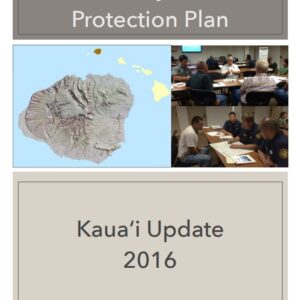Hawai‘i
Summary of Fire Past and Present
Wildfires in Hawaiʻi were once limited to those caused by active volcanic eruptions and infrequent dry lightning strikes. People first arrived to the islands between 1,000-4,000 years ago and, as everywhere else in the world, they brought change to the landscape. Nearly all fires in Hawaiʻi are human-caused and they often pose threats to communities and natural and cultural resources.
Having evolved in the absence of frequent fires, Hawaiʻi's native ecosystems are particularly vulnerable to fire disturbance, which is often associated with the spread and establishment of nonnative grass and shrub species. Over the past decade, Hawaiʻi has experienced an average of >1,000 ignitions burning >20,000 acres (8,000 ha) each year across the main inhabited islands. Fire response agencies are able to contain 90% of wildfire ignitions to less than one acre in size, but large fires (>1000 acres) have occurred on all islands, and happen multiple times each year across the state.
Hawaiian Islands

Hawai‘i Island
Hawaiʻi Island is unique in that it is the only Hawaiian island with ongoing active volcanic eruptions. However, humans are still by far the leading cause of wildfire ignitions. The…

Maui Nui (Maui, Moloka‘i, Lana‘i, Kaho‘olawe)
Maui Nui consists of four high islands–Maui, Lānaʻi, Molokaʻi, and Kahoʻolawe–and the small islet Molokini Crater. Each island has unique characteristics that affect their susceptibility to wildfires. The majority of…
Mapping Out the Past Century of Fire
Hawai‘i Wildfire Management Organization, University of Hawai‘i at Mānoa and partners are tracking Hawai‘i records for ignitions, the extent and perimeters of areas burned. To access these data >> CLICK HERE
Colonization (18 C. to present) Radically Transforms the Landscape to Include Fire
Since the arrival of European and American settlers in the late 18th century, the cultural and economic landscape of Hawaiʻi has undergone rapid and profound transformations. These changes, accompanied by the replacement of native ecosystems with invasive weedy plants, particularly fire-prone grasses, and the introduction of non-native animals, have brought significant alterations to the environment and fire dynamics. >>READ MORE
Today's Fire Challenges in Hawaiʻi
As the human population in Hawaiʻi has risen, ignitions have followed. The vast majority of ignitions in Hawaiʻi are caused by humans while wildfires spread across the expanse of non-native vegetation accounting for c. 25% of Hawaiʻi's land area. >> READ MORE
Maps, Images, Factsheets & Plans




Recent Resources For Hawai‘i
In this joint webinar hosted by the Pacific Fire Exchange and the Pacific Regional Invasive Species Climate Change, we tackle the climate crisis in Hawai`i and how this affects the risk of wildfire as well as the impacts to people and the archipelago’s unique resources.
In this Pacific Fire Exchange talk story Q&A session, we speak with Dr. Clay Trauernicht and Dr. Alyssa Anderson, University of Hawai`i at Mānoa about wildfire in Hawai`i in the context of Hawaiian language newspapers as well as the historical landscape changes of the 20th century.
In this Pacific Fire Exchange talk story Q&A session, we round up the latest research, past and present for managers and landowners wanting to understand more about how our four-legged friends (goats, sheep, cows, etc.) if managed properly can help reduce blazing and wildland fire. This month’s science share out and conversation was with Dr. Clay Trauernicht, University of Hawai`i at Mānoa Ecosystems and Fire Specialist; Raia Olsen of O‘ahu Grazers and Dr. Elliott Parsons, formerly with the Department of Land and Natural Resources. They presented the how-tos on hiring island professional grazers and lessons learned for contract grazing.







